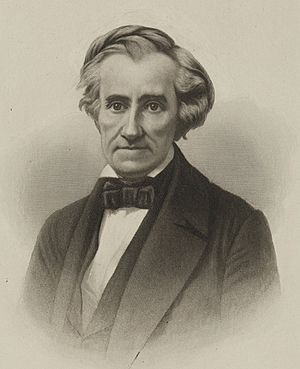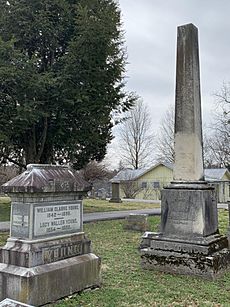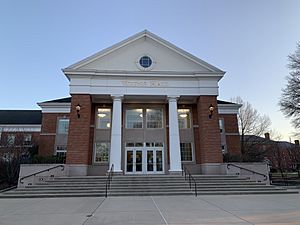John C. Young (college president) facts for kids
Quick facts for kids
John C. Young
|
|
|---|---|

Portrait by John Sartain
|
|
| 4th President of Centre College | |
| In office November 18, 1830 – June 23, 1857 |
|
| Preceded by | Gideon Blackburn |
| Succeeded by | Lewis W. Green |
| Personal details | |
| Born | August 12, 1803 Greencastle, Pennsylvania, US |
| Died | June 23, 1857 (aged 53) Danville, Kentucky, US |
| Resting place | Bellevue Cemetery, Danville, Kentucky |
| Spouses |
Frances Breckinridge
(m. 1829; died 1837)Cornelia Crittendon
(m. 1839) |
| Children | 10, including William |
| Education | Columbia College Dickinson College (1823) Princeton Theological Seminary (1828) |
| Signature | |
John Clarke Young (August 12, 1803 – June 23, 1857) was an American educator, pastor, and academic administrator who served as the fourth president of Centre College in Danville, Kentucky. A graduate of Dickinson College and Princeton Theological Seminary, he entered the ministry in Lexington, Kentucky, in 1828. He accepted the presidency of Centre College in 1830, and held that position until his death in 1857, making him the longest-serving president in the college's history. He is regarded as one of Centre's best presidents, as he increased the endowment of the "struggling" college more than five-fold during his term and increased the size of the graduating class from two students in his first year to forty-three in his final year.
During his time in office, he continued to preach, accepted the pastorate of the Danville Presbyterian Church in 1834 and founded the Second Presbyterian Church in Danville in 1852. Young was a respected member of the church and was elected moderator of the Presbyterian Church's General Assembly in 1853.
He is the namesake of numerous facets of the college today, including Young Hall, which is named for him and his son, William C. Young, who would later become the college's eighth president.
Early life and education
Young was born on August 12, 1803, in Greencastle, Pennsylvania, to Reverend John Young, a Presbyterian pastor, and Mary Clarke Young. He was the youngest child in his family, and his parents' only son. After the death of his father while John was still an infant, he was raised almost entirely by his mother and was educated at home by his grandfather, George Clark.
He moved to New York City to study at a classical school under John Borland, described as an "eminent teacher in the city of New York", before going to college. Young's uncle, Matthew St. Clair Clarke, a practicing lawyer and seven-term U.S. House Clerk, offered to mentor him in a law-based profession, but he declined and decided to follow his father into the ministry. Young enrolled at Columbia College (now Columbia University), where he spent three years. Young eventually transferred to Dickinson College, in his native Pennsylvania, and he graduated with honors in 1823. He spent two years after graduation teaching algebra at the classical school he attended in New York City for the first and serving as an assistant to the professor of mathematics at Columbia for the second. In 1825, Young enrolled at Princeton Theological Seminary, where he spent three years studying theology, and specifically the interpretation of the Bible based upon the principles of Scottish common sense realism. He also tutored students at the College of New Jersey (now Princeton University). Young graduated from Princeton Theological Seminary with a Doctor of Divinity degree in 1828.
Career
After receiving a license to preach from the Presbytery of New York on March 7, 1827, Young's career in the ministry began the following year following his graduation from Princeton. In 1828, he moved to Lexington, Kentucky, where he was appointed the pastorate of McChord Presbyterian Church (now the Second Presbyterian Church), founded in 1813 by James McChord, who was later elected as Centre's first president.
Centre's presidency became vacant in October 1830 when Gideon Blackburn resigned the office, prompting the college's trustees to venture east in search of a replacement. At the recommendation of Archibald Alexander, principal of Princeton Theological Seminary, they offered Young the position in a unanimous vote. Young accepted and was inaugurated as the fourth president of Centre College on November 18, 1830, at the age of 27.
He inherited a "struggling" college, which had graduated just 24 or 25 students over the course of its eleven-year history. Young's primary duty as president was raising funds which the college desperately needed. Early in his presidency, he went to New York in an attempt to do so, and was successful in raising $6,000 in order to sponsor two new professors. Additionally, he also succeeded in raising money from residents of Danville and other parts of Kentucky. Young also served on the college faculty as a professor of logic and moral philosophy, and he taught belles-lettres and political economy when the position was vacant. After his first academic year as president, he delivered the commencement address to the senior class on September 22, 1831.
During Young's tenure, the curriculum at Centre consisted of classics, mathematics, natural science, and history, all "taught within a Christian framework"; the college catalogue from 1866 notes that each day of classes began with the "worship of God" and that religious instruction and sermons, held on the first Monday of each week, were required for all students. While a member of Centre's faculty, Young was elected to membership of the Beta Theta Pi fraternity; this practice of electing members of a college's board of trustees or faculty was relatively common in the fraternity at the time. Centre graduated a fair proportion of its first notable alumni during Young's time in office; the class of 1855 alone consisted of John Y. Brown, Thomas Theodore Crittenden, Boyd Winchester, and William Campbell Preston Breckinridge. Other graduates during Young's term included John C. Breckinridge (1838), John Christian Bullitt (1849), John Marshall Harlan (1850), and Andrew Phelps McCormick (1854).
In 1834, Young became the pastor of the Danville Presbyterian Church, which served both students and the town at-large. He was popular with his congregation, which grew in size rapidly. A few years later, the Presbyterian Church found itself embroiled in the Old School–New School Controversy, an 1837 schism that split the church into "Old School" traditional Calvinist theological conservatives and "New School" revivalists. Young was a part of the "Old School", as was the Synod of Kentucky, many other southern synods, and both of Danville's Presbyterian Churches at which Young had preached. It was also around this time that Young was offered the presidency at Transylvania University due to his successes in Danville, though he ultimately opted to stay at Centre. In 1852, the congregation had outgrown the building, and Young founded a second church, the Second Presbyterian Church, in order to accommodate the large number of students that attended. The church remained operational until 1969, when the building was vacated and the congregations joined at the original First Presbyterian Church.
Young was among the delegates from the Synod of Kentucky to the 1853 General Assembly of the Presbyterian Church, held in Philadelphia. On May 20, 1853, the second day of the meeting, Young was elected to the office of moderator, earning the bare minimum number of votes necessary for a majority, 126 out of an available 251, and winning election on the first ballot. Commenting on Young's performance as moderator, a correspondent from The New York Times noted that he was "of decided ability". Later in the week, on May 23, Young and the other delegates from the Synod of Kentucky petitioned the General Assembly for $60,000 to be put towards land and trusts to build a "Seminary of the first class" in "the West", with a plot of "ten or more acres" in Danville being named as a specific location. This seminary later opened in Old Centre in 1853 as the Danville Theological Seminary, and moved to downtown Danville, in Constitution Square, the following year.
Personal life and death
Young married Frances Breckinridge, the sister of Centre graduate and future Vice President John C. Breckinridge, on November 3, 1829. The couple had four daughters, between 1831 and 1837. After Frances' death on November 2, 1837, Young would go on to remarry a few years later. In 1839, Young married Cornelia Crittenden, the daughter of Governor John J. Crittenden, to whom he would remain married until his death. The couple had six children between 1841 and 1849, including William C. Young, who would go on to graduate from Centre in 1859 and become Centre's eighth president in 1888.
Young suffered from poor health for the last several years of his life. Upon arriving at Centre in 1854, future college president William L. Breckinridge said in a letter to his father, "Dr. Young looks badly – the rest look well." Young died on June 23, 1857, at the age of 53. The cause of death was ultimately determined to have been stomach disease, which led to a hemorrhage. At the time of his death, he still held the presidency of the college. At his funeral, Robert Jefferson Breckinridge delivered the eulogy. Young was buried at Bellevue Cemetery, in Danville; his son, William, was eventually buried next to him. His successor to the presidency was Rev. Lewis W. Green, who was a faculty member for much of Young's time at the college. Green was elected to the position in August 1857 and began his term as president on January 1, 1858.
At the time of his death, Young was at work on a treatise entitled The Efficacy of Prayer, which was described by The Evangelical Repository as being "worthy of the subject and the author". The work would be published posthumously by the Presbyterian Board of Publishing. Young had given and published numerous other speeches, essays, and sermons over the course of his life, including a speech about temperance, a speech at the inauguration of the professors at the Danville Theological Seminary, and a sermon entitled "On the Sinfulness, Folly and Danger of Delay."
Young was also a proponent of the gradual emancipation of slaves, and gave several speeches advocating for it as a more moderate and reasonable alternative to immediate abolitionism. Young was a slaveholder himself, and freed some of his own slaves on two separate occasions. Young was a member of an 1835 committee that determined the Synod's position in support of gradual emancipation, and Young himself also supported the colonization of former slaves in Africa; the early 1850s saw four black members of his congregation emigrate to Liberia under this plan. He gave multiple speeches on this subject as well, including his Address to the Presbyterians of Kentucky, proposing a Plan for the Instruction and Emancipation of their Slaves (1834) and The Doctrine of Immediate Emancipation Unsound (1835), and proposed the addition of a clause providing for gradual emancipation in the new state constitution in 1849.
Legacy
Several aspects of Centre College are named in honor of Young. Young Memorial Hall, named for both John and William, was dedicated on January 8, 1909, and was the college's first building devoted entirely to science. This building was destroyed in a fire several days before its scheduled demolition, and was replaced by a new Young Hall, which was dedicated on March 21, 1970. The new building underwent renovations and a large addition was dedicated on October 21, 2011. The John C. Young Scholars program at Centre, founded in 1989 as the John C. Young honors program, also bears his name, as does the John C. Young Symposium, where the aforementioned scholars present research and projects which they worked on as a part of the program.
Regarded as one of Centre's best presidents, Young's administration had a lasting effect on the college. During the course of his term, which lasted nearly 27 years, the college's endowment grew to over $100,000, representing more than a five-fold increase, and the enrollment exceeded 250 students. Young's final graduating class, the class of 1857, boasted 47 members, which was Centre's largest-ever class at the time; this was a significant increase over the graduating class of two students which Centre produced in Young's first year in office. As of 2024[update], Young's nearly 27-year term still stands as the longest of any president in Centre's history, longer than Thomas A. Spragens, who served for 24 years from 1957 to 1981, and John A. Roush, who served for 22 years from 1998 to 2020.





